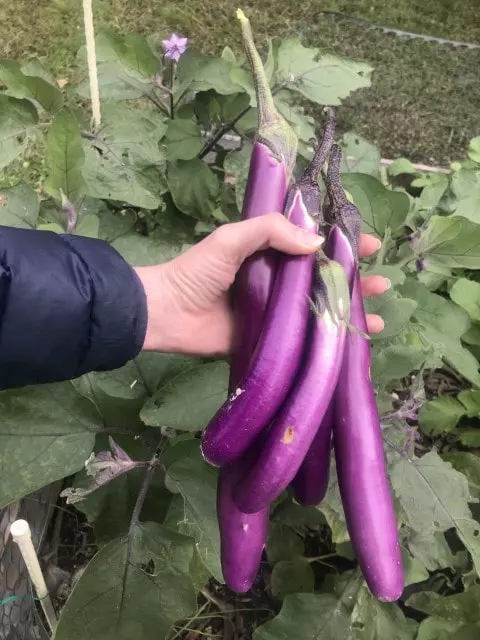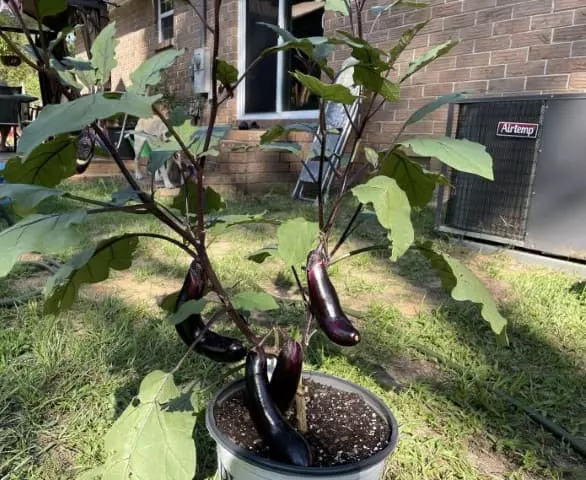The Japanese eggplant is long and thin, and its shape differs from the traditional eggplant. If you are growing Japanese eggplant for the first time, you may have concerns about how and when to harvest Japanese eggplant. Pick Japanese eggplants when they are young and before reaching their full size. These eggplants are best when they are tender and have slightly glossy skin. The most common varieties of Japanese eggplant are Orient Express, Millionaire, and Ichiban eggplants. How to know when they are ready to pick? Continue reading to learn gardening tips for a successful harvest.
As mentioned earlier, Japanese eggplants are longer and thinner than traditional ones. These eggplants have a slightly sweeter flavor and can be grown in smaller spaces.
Let’s see how and when to harvest Japanese eggplant correctly and how to know when are ready to pick.
Table of Contents
When to Harvest Japanese Eggplant
When to Harvest Japanese Eggplant? There is a wide variety of Japanese eggplants, but normally the fruits take 60 to 85 days to ripen, depending on the species. Below is a table with information about the number of days to maturity for diverse varieties that orient gardeners to know when to harvest Japanese eggplant.
| Japanese Eggplant Variety | Days to Maturity |
| Japanese Pickling | 75 – 85 |
| Ichiban | 55 – 60 |
| Japanese White Egg | 60 – 65 |
| Early Black Egg | 60 – 65 |
| Black Shine (Hybrid) | 65 – 70 |
| Shikou (Hybrid) | 70 – 80 |
| Millionaire Eggplant (Hybrid) | 55 – 65 |
| Yasakanaga (Hybrid) | 60 – 65 |
| Senryu Ni Gou (Hybrid) | 60 – 65 |
| Dewako One Bite (Hybrid) | 60 – 65 |
| Kurume Eggplant | 60 – 65 |
| Kyoto Egg (Hybrid) | 60 – 65 |
| Shoya Long (Hybrid) | 60 – 65 |
| Money Maker Eggplant (Hybrid) | 60 – 70 |
As you can see, the number of days it takes to ripen the fruits of Japanese eggplant varies slightly depending on the variety chosen for cultivation. For example, the best time to harvest Ichiban eggplant is about 55 days to maturity from planting the seeds. But it is not only important to count the number of ripening days to know when to harvest Japanese eggplant. It is also essential to observe the dimensions of the Japanese eggplant fruit to know when to harvest it correctly.
For example, the Ichiban variety of Japanese eggplant has fruit between 6” and 8” (15 to 20 cm) long. The Japanese White Eggplant variety has fruit 2” to 3” (5 to 8 cm) long, one of the smallest varieties. Note the dimensions of the eggplant variety you have chosen to know the correct harvest time.
Finally, to know when to harvest Japanese eggplant, look at the skin of the eggplant. It must have a bright color to be harvested and ready to pick. To the touch, the eggplant should be firm. If you press the eggplant with your hand, there should not be any marks. If you see a yellow eggplant on the plant, it is overripe and should not be consumed.

How to Harvest Japanese Eggplant
How to Harvest Japanese Eggplant? Harvesting Japanese eggplant is not difficult at all. You only need a knife or pruning shears. Before using the tools, disinfect them. Not all eggplants on the plant will ripen at the same time. Look at all your Japanese eggplants and only select the ripe ones to pick it.
Leave a small stem on the Japanese eggplant to keep it better for longer. The University of Georgia recommends never twisting the fruit to avoid damaging the plant. That is why you should use sharp and disinfected tools to make a perfect cut on the eggplant plant.
Japanese eggplant will continue to produce fruit throughout the summer until autumn, when the first frosts begin. Observe your eggplant plant daily to harvest the Japanese eggplants that are ripening day by day.
After harvesting Japanese eggplant, consuming the fruit as soon as possible is best. Japanese eggplant can be stored in the refrigerator for up to one week. In the crisper drawer of the refrigerator, you can store Japanese eggplant in a perforated plastic or paper bag for up to one week.

How to Grow Japanese Eggplant
How to Grow Japanese Eggplant? To grow Japanese eggplant at home, you will need seeds of any variety of Japanese eggplant, soil, and a seedbed or pots. Start growing Japanese eggplant indoors about six weeks before the last frost date, depending on your region.
- Fill your pots or seedbed with soil.
- Place the Japanese eggplant seeds on the soil’s surface and cover them with a thin layer of soil. Then water gently so that the seeds do not sink.
- Place the pots or seedbeds in a place with good lighting to start the germination process. It usually takes two weeks for Japanese eggplant sprouts to appear.
- While the Japanese eggplant seeds are germinating, select a spot in the garden where you will plant the Japanese eggplant. Eggplants grow in nutrient-rich, well-drained soils that receive several hours of sunlight.
- Once the Japanese eggplant seedlings are bigger and there is no risk of frost, plant them in the garden. Use mulch to allow the plants to retain moisture and prevent weeds.
These are the basic steps to grow Japanese eggplant. If you want to know more, we recommend our article about how to grow eggplant. Once the eggplant fruits have grown and ripened, you only need to apply what you have learned in this article on how and when to harvest Japanese eggplant.
- Highest Quality Fruit, Vegetable, Herb and Flower Seeds
- No Hassle Guarantee
- Sold and Shipped from the United States
Final Thoughts Regarding When To Pick Japanese Eggplant
Let’s see a couple of final thoughts about when to pick Japanese eggplant and how to harvest it correctly.
When reaching the days of maturity of the Japanese eggplant’s cultivar, gardeners should look for a uniform color on the Japanese eggplant’s skin. Refers to the table in this article or seeds supplier as each variety of Japanese eggplant may have different days to maturity, besides the growing conditions, which also affect the timing from growing to harvest. As mentioned in this article, the Ichiban eggplant is usually ready to harvest in about 55 days, while the Japanese pickling eggplant usually needs 80 days to reach maturity.
Depending on the variety, the Japanese eggplant’s skin color can range from deep purple to lighter shades of purple or even white. The skin should be smooth and shiny.
To check if they are ready to pick, gently press your finger against the eggplant’s skin. It should feel firm and bounce back slightly when you release the pressure. Check your Japanese eggplant plants regularly and harvest the eggplants as they reach the appropriate size. Regular harvesting encourages the plant to produce more fruit.
Remember to use pruning shears or a sharp knife to cut the stem about an inch above the eggplant when picking your crop. Be careful not to damage the plant while harvesting. I hope this article about how and when to harvest Japanese eggplant will be useful, and you will have an excellent harvest.
I recommend our other articles about how and when to harvest eggplant black beauty and how and when to harvest fairy tale eggplant.

